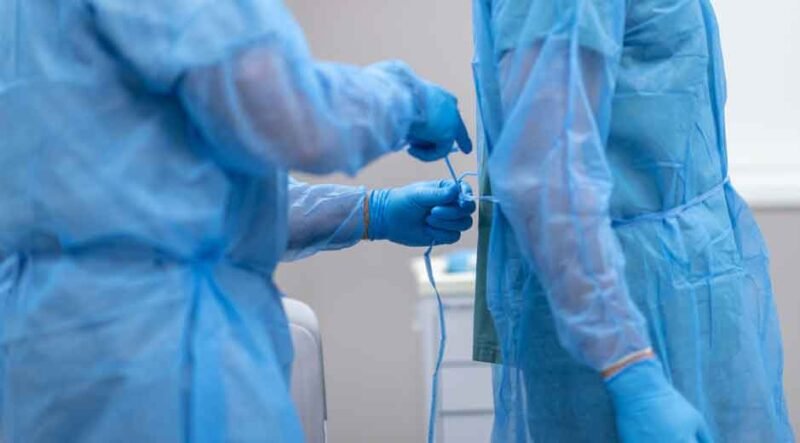Selecting the right isolation gowns is essential for protecting healthcare workers from potential exposure to infectious materials. These gowns serve as a vital barrier between medical professionals and contaminants, helping prevent the spread of infection within clinical settings. Material, fluid resistance, and design are all key factors to consider when evaluating which gown is appropriate for various levels of patient care and procedural risk.
Dental isolation gowns are vital in dental practices, where aerosol-generating procedures are standard. They provide coverage and protection while allowing flexibility and comfort for extended use. It’s essential for all healthcare facilities—whether hospitals, outpatient clinics, or dental offices—to assess their needs carefully when choosing gowns. Proper selection enhances staff safety and patient care quality across different medical environments.
Understanding Isolation Gown Materials
The type of material used in an isolation gown directly impacts the garment’s barrier properties, durability, and breathability. Understanding the advantages and potential limitations of each material type is crucial for informed purchasing decisions in healthcare environments.
- Polypropylene:This lightweight, nonwoven material is highly breathable, making it an excellent choice for low to moderate-risk settings where comfort and airflow are priorities. While it offers some fluid resistance, polypropylene may be best suited for routine examinations or short-duration use.
- Polyester:Known for its strength and potential for repeated use, polyester gowns often withstand laundering without significant degradation in barrier performance. Their durability and comfort are suitable for moderate-risk settings, including procedures involving limited fluid exposure.
- Polyethylene:This plastic-based film excels in high-level fluid resistance, making it ideal for aerosol-generating procedures or environments where heavy fluid contact is anticipated. Though less breathable, polyethylene gowns provide essential protection for healthcare workers facing increased exposure risk.
Working with a trusted dental supply company can help ensure access to gown materials tailored to meet specific procedural needs and regulatory standards. Selecting the correct material helps ensure gowns offer the necessary protection for particular tasks, promote staff compliance through comfort, and allow practices to align inventory with the frequency and severity of anticipated exposures.
Design Features and Their Importance
Well-engineered gown designs enhance overall protective performance, usability, and comfort for wearers engaged in demanding clinical routines. Several vital features distinguish effective isolation gowns:
- Coverage:Adequate coverage of the torso, arms, and upper legs provides a critical barrier against fluid splashes and droplets, minimizing routes for infection transmission.
- Closures:Secure closures, such as ties, snaps, or Velcro at the neck and waist, allow for a custom fit, maintaining garment integrity and reducing the risk of accidental exposure during movement.
- Cuffs:Elastic or knit wrist cuffs prevent sleeves from shifting, supporting consistent arm protection when worn with gloves.
User-friendly designs also promote proper doffing, which allows users to remove contaminated gowns without risking self-contamination. Adjustable closures and ergonomic fits improve compliance and ease of use, which are critical for high-paced clinical work.
Compliance with Standards
Uniform standards exist to help healthcare facilities verify that chosen gowns meet essential safety criteria. The ANSI/AAMI PB70 standard is particularly important. It classifies gowns into four levels based on their liquid barrier performance—from minimal, low-risk situations (Level 1) to high-risk surgical procedures (Level 4).
- Level 1: Minimal risk, basic care, standard isolation.
- Level 2: Low risk, blood draw, suturing.
- Level 3: Moderate risk, arterial blood draw, emergency room procedures.
- Level 4: High risk, long, fluid-intensive surgeries.
Adherence to these classifications helps protect healthcare workers, ensure regulatory compliance, and instill confidence in staff and patients.
Balancing Protection, Comfort, and Cost
While choosing the gown offering the highest protection seems ideal, practical considerations like comfort, supply logistics, and long-term cost must also be considered.
- Disposable gowns are frequently selected for their convenience and consistent barrier quality, but can lead to higher recurring costs and increased environmental waste.
- Reusable gowns offer durable protection, may present cost savings over time, and reduce environmental impact, but require a robust laundering and quality control protocol to maintain protective integrity.
Facilities must assess their risk profiles, daily procedure volumes, and available resources to identify a manageable, protective, and cost-effective solution.
Conclusion
Protecting healthcare personnel hinges on carefully selecting isolation gowns designed to meet both the situational demands of clinical practice and compliance regulations. By prioritizing informed material selection, evaluating protective and functional design elements, ensuring adherence to standards like ANSI/AAMI PB70, and pragmatically assessing cost and comfort, facilities can make decisions that enhance workplace safety. Trusted suppliers in the dental and healthcare sectors provide access to a range of products tailored to specific environments, ensuring staff are supported by PPE that empowers safe, effective patient care.








